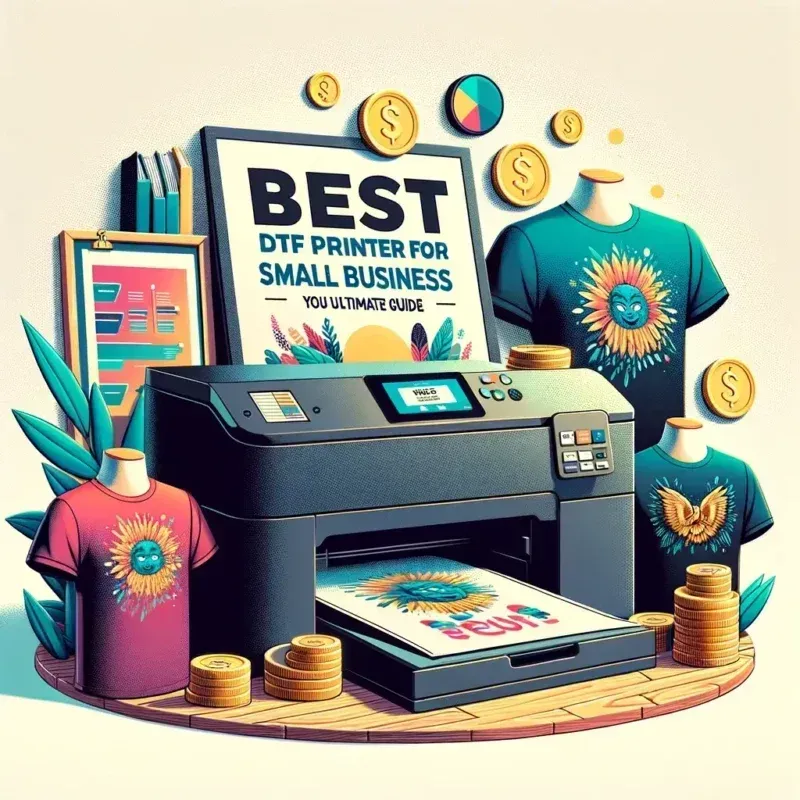Starting your own **DTF printing business** can be an exciting way to tap into the burgeoning market of custom apparel printing. As Direct to Film (DTF) printing gains traction, it opens up unique opportunities for entrepreneurs eager to provide vibrant, high-quality designs on various fabrics. This comprehensive guide will cover essential aspects, including the best DTF printing equipment, effective marketing strategies, and what you need to know about creating custom designs. With a well-structured approach, you can navigate the complexities of starting a custom printing business successfully. Whether you aspire to draw in local clients or establish an online store, understanding the nuances of DTF printing is key to capturing your audience’s imagination and fulfilling their printing needs.
Embarking on the journey to establish a custom printing business focused on DTF print technology is both a challenge and a rewarding quest. Direct to Film printing allows for a seamless transfer of stunning graphics onto textiles, making it a preferred method for producing personalized clothing items. This specialized printing technique harnesses innovative technology, available to budding entrepreneurs looking to carve out a niche in the fashion and merchandising industries. By exploring essential equipment and effective marketing techniques, you can set the groundwork for a successful enterprise in the ever-evolving world of apparel decoration. Engaging with market trends and community resources can enhance your proficiency as you venture into this creative field.
Understanding the DTF Printing Process
The DTF printing process, which stands for Direct to Film printing, consists of several crucial stages to ensure high-quality results. Firstly, the design is printed on a special transfer film using a DTF printer equipped with appropriate inks. What sets DTF apart from traditional printing methods is its ability to create stunning, vibrant colors that adhere impeccably to a multitude of fabric types. This versatility makes it a favored choice among custom apparel printing businesses, as it eliminates the constraints of other methods that may not work on certain surfaces.
After printing, the next step involves applying a special powder adhesive to the wet ink on the transfer film. This is then heat-cured, ensuring that the adhesive binds the design firmly to the film. Finally, the film is positioned onto the desired fabric and pressed with a heat press, allowing the design to transfer seamlessly onto the material. By understanding and mastering this process, aspiring entrepreneurs can effectively tap into the growing demand for custom printed products, thus thriving in their DTF printing ventures.
Key Equipment for Your DTF Printing Business
Choosing the right equipment is pivotal when starting your DTF printing business. At the heart of your operation is the DTF printer, which must be compatible with a variety of DTF inks to produce bright and long-lasting prints. Brands like Epson and Roland are renowned for their reliability and print quality, making them excellent choices. Additionally, the size of the printer should align with your business goals, especially if you plan to accommodate large-scale orders or intricate designs.
Alongside the printer, a high-quality heat press is essential for ensuring that your prints maintain integrity during the transfer process. The right heat press should offer precise temperature settings and even pressure to deliver optimal results. Furthermore, sourcing quality transfer films and DTF inks from reputable suppliers will significantly impact the durability and vibrancy of your final product. Investing in top-notch equipment will not only aid in producing superior prints but also facilitate smoother operations within your DTF printing business.
Creating an Effective DTF Printing Business Plan
A well-structured business plan lays the foundation for any successful DTF printing business. This document should clearly outline your business objectives, marketing strategies, target audience, and financial projections. Understanding your competition and defining your unique selling proposition (USP) will help you carve out a niche in the ever-expanding market of custom apparel printing.
Moreover, your business plan should include a detailed analysis of startup costs, including equipment purchases, raw materials, and operational expenses. By anticipating your financial needs and potential challenges, you can devise strategies to secure funding, whether through loans, grants, or personal investments. A comprehensive business plan not only directs your initial efforts but also serves as a valuable tool when approaching potential investors or partners.
Marketing Strategies for Your DTF Printing Business
Effective marketing is crucial to the success of your DTF printing business. Utilize social media platforms like Instagram and Facebook, where visually appealing content thrives. Showcase your high-quality prints and unique designs through stunning imagery that captures the essence of your products. Engaging actively with your audience helps foster community and brand loyalty, making it easier to build a customer base within the custom apparel market.
In addition to social media, consider offline marketing strategies like attending local craft fairs or collaborating with businesses that may require custom apparel. Networking with other entrepreneurs can lead to mutually beneficial partnerships and increased visibility for your brand. Don’t underestimate the power of word-of-mouth referrals; consistently delivering quality products and exceptional customer service will encourage satisfied customers to share their experiences.
Navigating Legal Requirements for Your DTF Printing Business
Starting a DTF printing business comes with specific legal requirements that entrepreneurs must navigate. First, registering your business name and obtaining the necessary licenses or permits is essential to operate legally. Depending on your location, this may involve local business licenses, sales tax permits, and potentially additional approvals specific to home-based businesses.
Moreover, it’s vital to familiarize yourself with local regulations regarding health and safety, environmental compliance, and employment if you plan to hire staff. Remaining compliant not only shields you from legal issues but also enhances your business’s credibility and community standing.
Leveraging Community Resources for Your DTF Printing Business
Utilizing community resources can greatly benefit your DTF printing business as you start your entrepreneurial journey. Local print shops often provide valuable insights and knowledge about the industry, while also offering networking opportunities. Joining groups or associations focused on printing can connect you with experienced professionals who can mentor you in navigating common challenges.
Additionally, online platforms hosting forums for DTF printing enthusiasts enable budding entrepreneurs to share tips, troubleshoot issues, and exchange design ideas. Engaging with these communities fuels personal growth and professional development, ensuring that you stay updated on the latest trends, techniques, and equipment in the DTF printing industry.
Frequently Asked Questions
What do I need to start a DTF printing business?
To start a DTF printing business, you will need essential equipment such as a high-quality DTF printer, heat press, transfer films, DTF inks, and graphic design software. Research suppliers for these materials to ensure you have everything necessary for producing custom apparel.
How can I effectively market my DTF printing business?
You can effectively market your DTF printing business through social media marketing, attending local events, and partnering with businesses that require custom apparel. Showcasing your vibrant designs online and engaging with your audience will help attract potential customers.
What legal requirements should I consider when starting a DTF printing business?
When starting a DTF printing business, ensure you register your business, secure any necessary permits or licenses, and comply with local regulations. Understanding these legal requirements is essential to operate your business smoothly.
What is the significance of quality control in a DTF printing business?
Quality control is crucial in a DTF printing business because it ensures the accuracy, clarity, and durability of your prints. Implementing regular checks helps maintain consistent quality, enhancing customer satisfaction and building your reputation.
How can I create compelling designs for my DTF printing business?
To create compelling designs for your DTF printing business, utilize graphic design software like Adobe Illustrator. Familiarize yourself with DTF printing techniques to ensure your designs are optimized for the printing process.
What are some recent trends in the DTF printing business?
Recent trends in the DTF printing business include increased popularity due to its versatility with various fabric types, and technological advancements that enhance printing efficiency. Keeping abreast of these trends can help your business stay competitive in the industry.
| Key Steps to Start DTF Printing | |
|---|---|
| Research and Planning | Conduct market analysis and create a business plan to understand the competitive landscape and define objectives. |
| Essential Equipment and Supplies | Invest in a DTF printer, heat press, transfer films, inks, and graphic design software to ensure quality output. |
| Workspace Setup | Establish a sufficient workspace, prioritize ventilation, and consider e-commerce options to reach customers online. |
| Legal Requirements | Register your business and obtain necessary permits, complying with local regulations to operate legally. |
| Marketing Your Business | Utilize social media, attend local events, and partner with businesses to grow your customer base and visibility. |
| Quality Control | Implement strict quality control measures to ensure the durability and accuracy of prints, enhancing customer satisfaction. |
| Recent Trends | DTF printing is growing in popularity, supported by technological advancements and a rise in demand for customization. |
| Education and Resources | Explore online courses and community support for continuous learning about DTF printing techniques and trends. |
Summary
The DTF printing business is a promising venture for aspiring entrepreneurs seeking to make their mark in the custom printing industry. With its ability to produce high-quality prints on various fabrics, DTF printing not only meets the growing demand for personalized apparel but also opens new avenues for creativity and collaboration. A well-thought-out business plan and strategic marketing efforts, combined with quality equipment and an understanding of current trends, can significantly influence your success. Engaging with the DTF community and continuously honing your skills will further enhance your capabilities, allowing you to create unique, vibrant designs that attract a loyal customer base. By effectively leveraging these insights, you can position your DTF printing business to thrive, capturing the attention of both local and online markets.



